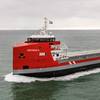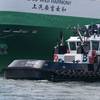Wärtsilä Common-Rail Engine Completes Shop Test
Developed by Wärtsilä Corporation, Sulzer RT-flex engines are advanced large marine engines available for ship propulsion. They are the first low-speed diesel engines to have electronically-controlled common-rail systems. This gives unrivalled flexibility in the way the engines operate, to deliver benefits such as smokeless operation at all operating speeds, lower fuel consumption, reduced maintenance costs and lower steady operating speeds for better manoeuvring. With the successful testing of the Sulzer RT-flex96C engine, common-rail technology has been proven to be an excellent step forward for all sizes of diesel engines from automotive engines up to the largest low-speed two-stroke engines. For Sulzer RT-flex engines, a key virtue of common-rail systems has been that they can be modular with standardised hardware applicable to more than one engine bore size. Built under license from Wärtsilä Corporation by HSD Engine Co Ltd in Korea, the engine tested is an eight-cylinder engine. It is one of four ordered in 2003 for four 3700 TEU L-class container ships contracted at Odense Steel Shipyard A/S in Lindø, Denmark, by the Danish group A.P. Møller-Maersk (three vessels) and Deutsche Afrika Line GmbH & Co (one vessel). The engine was first started on 24 March 2004 and completed testing on 9 April 2004 with its official shop test. After being run-in, the engine was subjected to an intensive eight-day test programme to check, adjust and confirm the engine control system and all aspects of engine performance. Throughout the tests, the engine ran very satisfactorily. All the tests were completed without difficulties. Measured fuel consumptions were completely in accordance with expectations at both full load and right across the part-load range. The measured NOX emissions were sufficiently below the limit set in Annex VI of the MARPOL 73/78 convention. Smokeless operation was also clearly confirmed. The official shop test was witnessed by representatives of the shipowner, shipbuilder and classification society. All parties were extremely satisfied with how the engine ran during the test. The Sulzer RT-flex96C engine has been extremely successful in the market. A total of 59 engines have been ordered since the engine type was introduced at the beginning of 2003.












